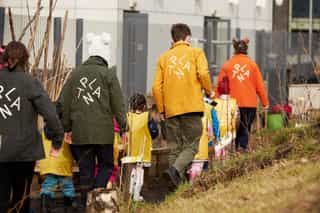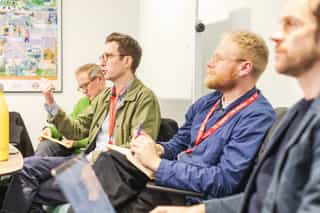Regenerative Urbanism - Principle 1: Designing for co-evolution
InsightsHuman ecosystems, through conscious participation, can contribute to the continued evolution of living systems. Designers must work creatively with the forces of change by recognizing the continuous process.
As part of my previous post on the 10 principles of Regenerative Urbanism, this article deep dives into the first principle: Designing for Co-Evolution.
Human ecosystems, through conscious participation, can contribute to the continued evolution of living systems. Designers must work creatively with the forces of change by recognizing the continuous process.
Our work on the NOMA Estate exemplifies this principle. Planit and Standard Practice (now Altogether Otherwise Limited) collaborated to work with emergent communities, facilitating their collective development and fusing this with their resource needs, while helping them forge a purpose and role for this new neighbourhood within the wider city context.
Understanding Diversity and Exchange Value
Diversity is about exchange value; having diverse elements (such as buildings on a site) adds nothing if there is no beneficial exchange of resources, energy, or materials among them. At NOMA Estate, Standard Practice created exchange value through a new collective intelligence embedded within the surrounding community, developed through the collaborative community crafting of the Pilcrow Pub through workshops. The pub activated the blank elevation of Sadler's Yard, a new square forming the heart of the area, while drawing footfall through the nascent neighbourhood.
Building Regenerative Communities
Regenerative approaches focus on building capacity within living communities to evolve to greater value—examining what living entities produce. This is a nested phenomenon, with each system contributing to larger systems. Standard Practice temporarily occupied historic, vacant buildings, organising community-building activities and giving them new purpose, thus curating the emergence and meaning of the NOMA Estate within its users' hearts.
A regenerative project seeks to build evolutionary capacity into the systems it serves—communities, organizations, and watersheds—transforming human communities into living systems enablers. Through Plant CIC, participants developed approaches to urban food growing while simultaneously enriching the urban ecosystem.
Four Key Principles of Co-Evolution
- Focus on Social Flows and Exchanges: Sustainable density isn't just about homes per hectare, but the number of social and economic exchanges within or flowing through a site. At Corridor Manchester, spaces like Circle Square, @City Labs and Brunswick Park facilitate the convergence of business, academic, and community development networks.
- Utilise Community Design Intelligence: Leverage people's deep understanding of how place has evolved over time and the forces that shaped its characteristics. This includes indigenous knowledge of water flows, geology, and microclimate.
- Stimulate Collaborative Frameworks: Act as enablers between city-wide governance and neighbourhood collectives. The Participatory City movement in Dagenham demonstrates how self-organised governance structures and social entrepreneurialism can emerge from prototype urban interventions.
- Design for Value Generation: Transform neighbourhoods from consumption systems into producers of cultural and economic wealth. This includes connecting with the bioregion's natural capacity to create local goods and services and encourage ecotourism, as exemplified by the UK's seven UNESCO -designated Biospheres.
Framework for Evolution
As @Kelvin Campbell notes in his book "Massive Small Change," in order to design for evolution, designers should create a framework for evolution to occur. This can comprise:
- Simple protocols: Rules that guide complex choices and achieve solutions
- Starter conditions: Principle-based conditions providing balanced constraints for emergence and innovation
- Enabling behaviours: Appropriate forms of leadership, management, and ethics governing behaviour
Based on the 4 key principles outlined above, the framework should also include a collaborative approach to align personal goals and strengths with those of the collective place vision, with a focus around adding value through
Conclusion
Designing for evolution doesn't mean designing evolution itself but rather maintaining its potential and aligning community wisdom with nature as the master developer.
Importantly, the standard design process can be externally imposed on a community or place, reinforcing reductionism and separation. True co-evolution emerges from designing collaboratively from within the system—which is why our most successful projects stem from becoming custodians of the places we serve.
Related Thoughts

Power of Networks

Power of Networks

Climate Emergency and Public Realm Carbon Assessment Roundtable

Climate Emergency and Public Realm Carbon Assessment Roundtable

Planit’s Urban Design team create a new vision for Hull



